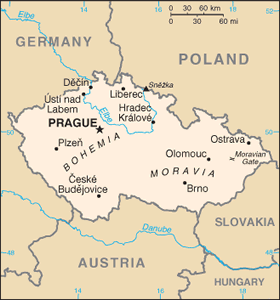The Geography of Czech Republic
The Geography of Czech Republic
Czech Geography
Location: Central Europe, between Germany, Poland, Slovikia, and Austria
Geographic coordinates: 49 45 N, 15 30 E
Map references: Europe
Area: total: 78,866 sq km land: 77,276 sq km water: 1,590 sq km
Area - comparative: slightly smaller than South Carolina
Land boundaries: total: 1,989 km border countries: Austria 362 km, Germany 815 km, Poland 615 km, Slovakia 197 km
Coastline: 0 km (landlocked)
Maritime claims: none (landlocked)
Climate: temperate; cool summers; cold, cloudy, humid winters
Terrain: Bohemia in the west consists of rolling plains, hills, and plateaus surrounded by low mountains; Moravia in the east consists of very hilly country
Elevation extremes: lowest point: Elbe River 115 m highest point: Snezka 1,602 m
Natural resources: hard coal, soft coal, kaolin, clay, graphite, timber
Land use: arable land: 38.82% permanent crops: 3% other: 58.18% (2005)
Irrigated land: 240 sq km (2003)
Natural hazards: flooding
Environment - current issues: air and water pollution in areas of northwest Bohemia and in northern Moravia around Ostrava present health risks; acid rain damaging forests; efforts to bring industry up to EU code should improve domestic pollution
Environment - international agreements: party to: Air Pollution, Air Pollution-Nitrogen Oxides, Air Pollution-Persistent Organic Pollutants, Air Pollution-Sulfur 85, Air Pollution-Sulfur 94, Air Pollution-Volatile Organic Compounds, Antarctic-Environmental Protocol, Antarctic Treaty, Biodiversity, Climate Change, Climate Change-Kyoto Protocol, Desertification, Endangered Species, Environmental Modification, Hazardous Wastes, Law of the Sea, Ozone Layer Protection, Ship Pollution, Wetlands, Whaling signed, but not ratified: none of the selected agreements
Geography - note: landlocked; strategically located astride some of oldest and most significant land routes in Europe; Moravian Gate is a traditional military corridor between the North European Plain and the Danube in central Europe


